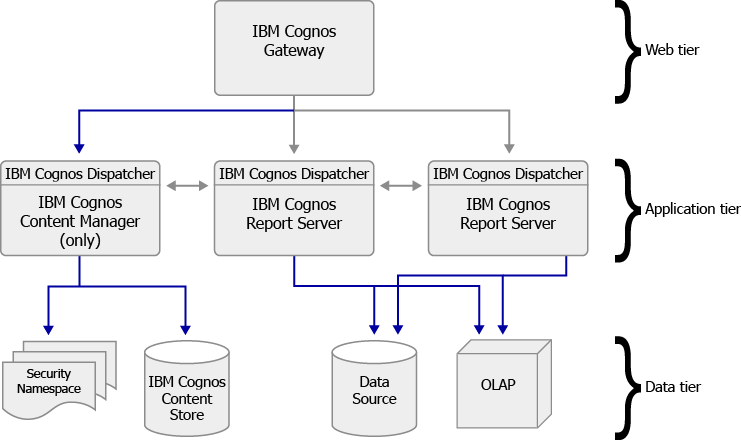IBM Cognos architecture
In this topic
- Web Tier: The IBM Cognos BI Gateway
- Application Tier: IBM Cognos BI servers
- Data Tier: Content providers
- Example IBM Cognos deployment
The following is a high-level overview of the IBM Cognos Business Intelligence architecture. For more detailed information, see the IBM Cognos Business Intelligence Architecture and Deployment Guide.
IBM Cognos is a web-based service-oriented architecture (SOA) made up of three server tiers:
- Web Tier
- Application Tier
- Data Tier
Within the IBM Cognos platform, servers are normally grouped together to fulfill certain roles within a distributed deployment. These server roles define the tier within the architecture that an IBM Cognos BI server uses. The tiers are based on business function and are typically separated by network firewalls.
Web Tier: The IBM Cognos BI Gateway
The Web Tier facilitates user connections to IBM Cognos BI applications, and the component that fulfills this role is the IBM Cognos Gateway. The IBM Cognos Gateway manages all web communication for the IBM Cognos platform. High availability or scalability requirements can be met with multiple redundant gateways being deployed along with an external HTTP load-balancing router.
Web communication in IBM Cognos Business Intelligence is typically through gateways, which reside on one or more web servers. A gateway is an extension of a web server program that transfers information from the web server to another server.
Web communication can also occur directly with an IBM Cognos BI Dispatcher, although this option is less common than using gateways.
If you install the gateway component on a different computer from Content Manager or Application Tier components, you must configure the gateway computer so that it knows the location of a dispatcher, preferably one on an Application Tier components computer. For failover protection, you can configure more than one dispatcher for a gateway computer.
Application Tier: IBM Cognos BI servers
The Application Tier contains one or more IBM Cognos BI servers. An IBM Cognos BI server runs requests, such as reports, analyses, and queries, that are forwarded by a gateway. An IBM Cognos BI server also renders the Cognos Connection interface.
The application tier is made up of three main server components:
- IBM Cognos Dispatcher
- IBM Cognos Report Server
- IBM Cognos Content Manager
IBM Cognos Dispatcher
The dispatcher starts all IBM Cognos services configured and enabled on a computer and routes requests. The dispatcher can route requests to a local service, such as the report service, presentation service, job service, or monitor service. A dispatcher can also route requests to a specific dispatcher to run a given request. Requests can be routed to specific dispatchers based on load-balancing needs, or package or user group requirements.
When you configure IBM Cognos BI gateways, you can list the universal resource identifiers (URIs) of target dispatchers in order of preference, from most to least preferred. If a dispatcher fails, requests are routed to another dispatcher based on the list. When a dispatcher starts, it registers itself with Content Manager. As a result, each dispatcher is aware of the other dispatchers. If a dispatcher fails or is unavailable, requests for that dispatcher are routed to the next available dispatcher until the failed dispatcher reregisters itself.
IBM Cognos Report Server
After IBM Cognos BI is installed and configured, one dispatcher is available on each computer by default. Each dispatcher has a set of associated services. IBM Cognos Dispatcher starts IBM Cognos Report Server processes dynamically as needed to handle the request load.
A complete list of the services available is beyond the scope of this document. The following services are noted because they have a direct impact on how Esri Maps for IBM Cognos is installed and configured.
Presentation service:
- Transforms generic XML responses from another service into output format, such as HTML or PDF
- Provides display, navigation, and administration capabilities in IBM Cognos Connection
Report service:
- Manages interactive requests to run reports and provides output for a user in IBM Cognos Connection or a studio
IBM Cognos Content Manager
IBM Cognos Content Manager is the IBM Cognos platform service that manages (among other things) the storage of the following application information: security settings and configurations, server configuration settings, packages, report specifications, and report output. IBM Cognos Content Manager maintains information in a relational database referred to as the content store database.
A minimum of one IBM Cognos Content Manager is required for each IBM Cognos platform implementation.
Data Tier: Content providers
The IBM Cognos Business Intelligence Data Tier contains the following:
- Content Store—A relational database that contains data the IBM Cognos BI product needs to operate, such as report specifications, published models, and the packages that contain them; connection information for data sources; information about the external namespace, and the Cognos namespace itself; and information about scheduling and bursting reports.
- Data Sources—The data sources that can be accessed through IBM Cognos BI include relational databases, dimensional or OLAP cubes, flat files, and other physical data stores. They also include the connection information necessary for accessing the data.
Example IBM Cognos deployment
The following illustrates an example IBM Cognos deployment. There are three dispatchers: one server running Content Manager and two servers acting as the report server role.

See the IBM Cognos Business Intelligence Installation and Configuration Guide for complete information about the IBM Cognos installation and initial configuration process.
For detailed information about IBM Cognos platform architecture and server deployment options, refer to the IBM Cognos BI Architecture and Deployment Guide.